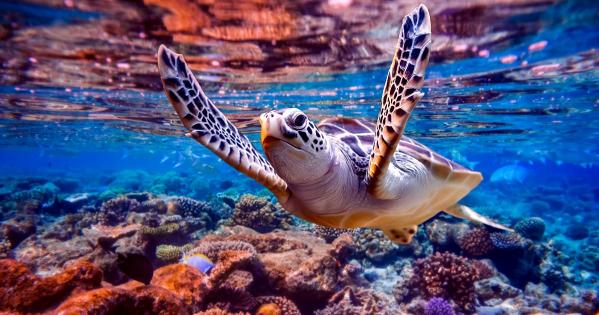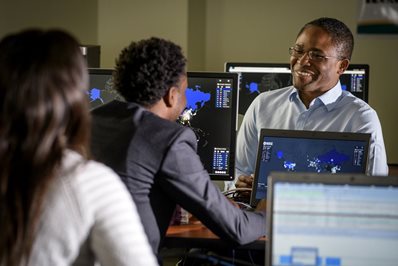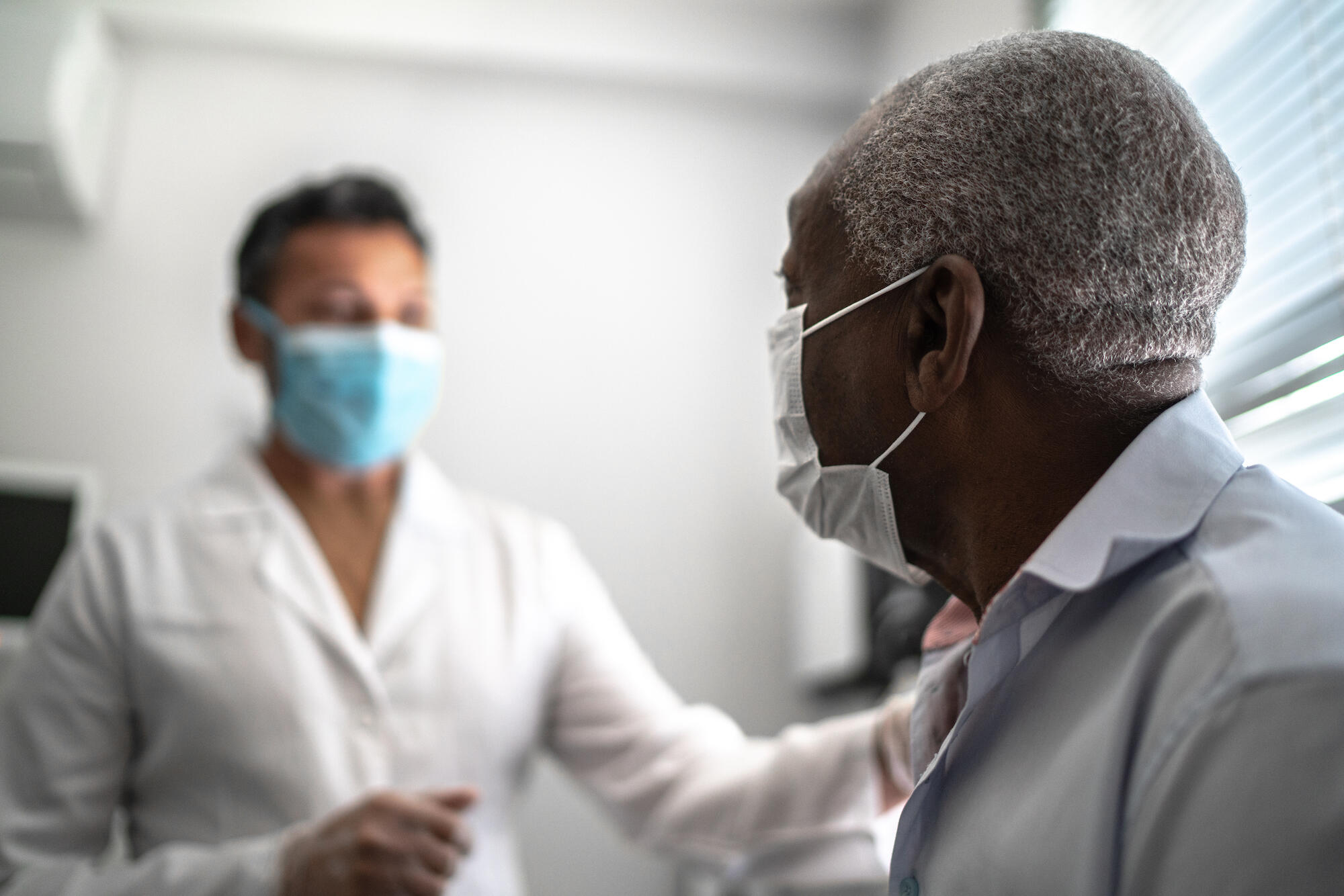Going Green: AU Environmental Scientists Work to Save Our Planet
American University, the first research university in the nation to reach carbon neutrality

American University, the first research university in the nation to reach carbon neutrality, has a deep commitment to creating a healthier planet. Nowhere is this more apparent than in the research being conducted in AU’s Department of Environmental Science, where faculty and students are working on research with real-life implications for our planet’s lands, oceans, and wildlife.
The department’s growth and influence have been extraordinary. When Marine Ecologist and Professor Kiho Kim first started teaching at AU 22 years ago, no environmental science department existed at the university. “We had a program with about seven majors, but I knew from talking with students that we could do better,” he says. Since then, Kim has been instrumental in building up a dedicated community of scholars and doers around issues of sustainability, which is a natural space for the university’s mission of producing changemakers for a changing world.
The work has paid off. Since the department was officially established in 2008, it has become one the biggest producers of Udall Scholars (the nationally competitive award for undergraduates interested in environmental issues) and has received a long line of prestigious research grants including a recent $15 million National Science Foundation award to study the issue of food waste in our nation.
Climate Change, Pollution, and Our Coral Reefs
For the past ten years, Kim and his students have traveled for field work in Guam and Saipan. Their goal is to understand how climate change and pollution affect the health of tropical ecosystems like coral reefs and seagrass beds. Kim recently returned from American Samoa, where he worked with Department Chair Karen Knee and University of Hawaii collaborators to determine where and how much pollution is entering Nu`uuli Pala Lagoon, the largest remaining (and most threatened) wetland in American Samoa. The project used spatial surveys and tidal time series of radon, a natural tracer of groundwater discharge, to map groundwater discharge into the lagoon and reef and determine how it varies in space and time. The team measured concentrations of pollutants (such as nutrients, trace metals, pesticides, pharmaceuticals, and personal care products) and used radium to estimate how quickly the water in the lagoon is replaced by oceanic water.
Kim and his collaborators are using this information to identify pollution hotspots, calculate how long pollutants remain in lagoon water and reef front, and assess the importance of groundwater and surface water as pathways of pollutant transport. They are sharing these data with the American Samoa Environmental Protection Agency, the Department of Marine and Wildlife Resources, and other local agencies to inform management decisions as they work to protect the health of the lagoon and reefs. Knowing how pollutants are getting into the lagoon – whether by surface runoff or groundwater, or both — is critical for developing effective mitigation strategies.
Global Seafood Trade, Ocean Health, and Ocean Species
Kim’s colleague, Professor Jessica Gephart is also working to protect the oceans, but from a different vantage point. Gephart researches the global seafood trade and its environmental impacts. Her biggest — and very ambitious — project right now is the development of a global seafood trade database. Although seafood is the most highly traded food in the world, no one really knows some of the most basic things about the seafood trade, like what percentage of all global seafood trade is wild caught versus what percentage is farmed.
Gephart’s database will feature a public data portal so anyone can access and download the data. “In this way, the database is planned to serve as a public good,” she says. And already, the database is spurring new research on trade of illegally sourced seafood and informing advocacy work around the trade of sardines in the Philippines and fishmeal out of West Africa, both cases where there are environmental justice concerns around fish exports.
Students Are Part of the Process
Gephart says it has always been important for her to focus on issues with real world implications and provide a space for students to both learn about the complexities of addressing food system problems and find where they might be able to contribute to solutions.
Kiho agrees. “At AU, students are a part of the research process,” he says. “I am really proud of the research at AU, but the thing I am most proud of is the students who have worked with me on my research.” This list includes 27 undergraduate students who have collectively won 32 competitive awards and recognitions from institutions including the US Fulbright Program, Carnegie Endowment, Environmental Protection Agency, and National Science Foundation. Students have coauthored papers with Kim, including two undergraduates who had the rare opportunity to serve as lead authors. Kim stays connected with many of these students who have gone on to graduate school, medical school (including MD-PhD programs), law schools, and careers in public service, private industry, and teaching.
A Supportive Atmosphere to Make Change Possible
What first attracted Kim to AU was the university’s commitment to both teaching and research, and a strong commitment to undergraduate education. “My first couple of years at college were a struggle, and it was connecting with a faculty mentor that turned things around and put me on a path that brought me here,” he says. “I am deeply indebted to my faculty mentor with whom I am still in touch, and I am equally grateful that being at AU has allowed me to pay that debt forward.”
Gephart also appreciates the university’s support. “My work, and all food systems work, is inherently deeply transdisciplinary. Although many universities say they want to do transdisciplinary work, not all are prepared to support researchers that don’t fit neatly into existing research silos, so I feel really lucky to have AU supporting me and my work. Also, being in DC is ideal for connecting with decision-makers and advocates. Over the past few years, I have been able to meet with representatives from NOAA (National Oceanographic and Atmospheric), the US State Department, the World Bank, and the United Nations FAO. I’ve also worked with environmental non-profits like Oceana, The Nature Conservancy, and the Environmental Defense Fund.”
Looking forward, Gephart is especially looking forward to hosting a data hackathon-style event next summer that will bring small interdisciplinary teams of early career scientist together at AU to tackle pressing questions about the seafood trade, the environment, and human nutrition. And for his part, Kim is excited about the 15-million-dollar food waste grant. "It is currently supporting 24 AU students in research. I am sure this number will grow as the full range of activities kick into gear, and I think this will continue to elevate AU as a truly student-centered research institution that is doing some cool and innovative work in sustainability.”
 Zone 2A - AVAILABLE FOR ADVERTISING
Zone 2A - AVAILABLE FOR ADVERTISING
 Zone 2B - AVAILABLE FOR ADVERTISING
Zone 2B - AVAILABLE FOR ADVERTISING
 Zone 2C - AVAILABLE FOR ADVERTISING
Zone 2C - AVAILABLE FOR ADVERTISING
Medical Schools / Universities Health Research & Education:
Going Green: AU Environmental Scientists Work to Save Our Planet
American University, the first research university in the nation to reach carbon neutrality

American University, the first research university in the nation to reach carbon neutrality, has a deep commitment to creating a healthier planet. Nowhere is this more apparent than in the research being conducted in AU’s Department of Environmental Science, where faculty and students are working on research with real-life implications for our planet’s lands, oceans, and wildlife.
The department’s growth and influence have been extraordinary. When Marine Ecologist and Professor Kiho Kim first started teaching at AU 22 years ago, no environmental science department existed at the university. “We had a program with about seven majors, but I knew from talking with students that we could do better,” he says. Since then, Kim has been instrumental in building up a dedicated community of scholars and doers around issues of sustainability, which is a natural space for the university’s mission of producing changemakers for a changing world.
The work has paid off. Since the department was officially established in 2008, it has become one the biggest producers of Udall Scholars (the nationally competitive award for undergraduates interested in environmental issues) and has received a long line of prestigious research grants including a recent $15 million National Science Foundation award to study the issue of food waste in our nation.
Climate Change, Pollution, and Our Coral Reefs
For the past ten years, Kim and his students have traveled for field work in Guam and Saipan. Their goal is to understand how climate change and pollution affect the health of tropical ecosystems like coral reefs and seagrass beds. Kim recently returned from American Samoa, where he worked with Department Chair Karen Knee and University of Hawaii collaborators to determine where and how much pollution is entering Nu`uuli Pala Lagoon, the largest remaining (and most threatened) wetland in American Samoa. The project used spatial surveys and tidal time series of radon, a natural tracer of groundwater discharge, to map groundwater discharge into the lagoon and reef and determine how it varies in space and time. The team measured concentrations of pollutants (such as nutrients, trace metals, pesticides, pharmaceuticals, and personal care products) and used radium to estimate how quickly the water in the lagoon is replaced by oceanic water.
Kim and his collaborators are using this information to identify pollution hotspots, calculate how long pollutants remain in lagoon water and reef front, and assess the importance of groundwater and surface water as pathways of pollutant transport. They are sharing these data with the American Samoa Environmental Protection Agency, the Department of Marine and Wildlife Resources, and other local agencies to inform management decisions as they work to protect the health of the lagoon and reefs. Knowing how pollutants are getting into the lagoon – whether by surface runoff or groundwater, or both — is critical for developing effective mitigation strategies.
Global Seafood Trade, Ocean Health, and Ocean Species
Kim’s colleague, Professor Jessica Gephart is also working to protect the oceans, but from a different vantage point. Gephart researches the global seafood trade and its environmental impacts. Her biggest — and very ambitious — project right now is the development of a global seafood trade database. Although seafood is the most highly traded food in the world, no one really knows some of the most basic things about the seafood trade, like what percentage of all global seafood trade is wild caught versus what percentage is farmed.
Gephart’s database will feature a public data portal so anyone can access and download the data. “In this way, the database is planned to serve as a public good,” she says. And already, the database is spurring new research on trade of illegally sourced seafood and informing advocacy work around the trade of sardines in the Philippines and fishmeal out of West Africa, both cases where there are environmental justice concerns around fish exports.
Students Are Part of the Process
Gephart says it has always been important for her to focus on issues with real world implications and provide a space for students to both learn about the complexities of addressing food system problems and find where they might be able to contribute to solutions.
Kiho agrees. “At AU, students are a part of the research process,” he says. “I am really proud of the research at AU, but the thing I am most proud of is the students who have worked with me on my research.” This list includes 27 undergraduate students who have collectively won 32 competitive awards and recognitions from institutions including the US Fulbright Program, Carnegie Endowment, Environmental Protection Agency, and National Science Foundation. Students have coauthored papers with Kim, including two undergraduates who had the rare opportunity to serve as lead authors. Kim stays connected with many of these students who have gone on to graduate school, medical school (including MD-PhD programs), law schools, and careers in public service, private industry, and teaching.
A Supportive Atmosphere to Make Change Possible
What first attracted Kim to AU was the university’s commitment to both teaching and research, and a strong commitment to undergraduate education. “My first couple of years at college were a struggle, and it was connecting with a faculty mentor that turned things around and put me on a path that brought me here,” he says. “I am deeply indebted to my faculty mentor with whom I am still in touch, and I am equally grateful that being at AU has allowed me to pay that debt forward.”
Gephart also appreciates the university’s support. “My work, and all food systems work, is inherently deeply transdisciplinary. Although many universities say they want to do transdisciplinary work, not all are prepared to support researchers that don’t fit neatly into existing research silos, so I feel really lucky to have AU supporting me and my work. Also, being in DC is ideal for connecting with decision-makers and advocates. Over the past few years, I have been able to meet with representatives from NOAA (National Oceanographic and Atmospheric), the US State Department, the World Bank, and the United Nations FAO. I’ve also worked with environmental non-profits like Oceana, The Nature Conservancy, and the Environmental Defense Fund.”
Looking forward, Gephart is especially looking forward to hosting a data hackathon-style event next summer that will bring small interdisciplinary teams of early career scientist together at AU to tackle pressing questions about the seafood trade, the environment, and human nutrition. And for his part, Kim is excited about the 15-million-dollar food waste grant. "It is currently supporting 24 AU students in research. I am sure this number will grow as the full range of activities kick into gear, and I think this will continue to elevate AU as a truly student-centered research institution that is doing some cool and innovative work in sustainability.”
Source: american.edu
 Zone 2A - AVAILABLE FOR ADVERTISING
Zone 2A - AVAILABLE FOR ADVERTISING
 Zone 2B - AVAILABLE FOR ADVERTISING
Zone 2B - AVAILABLE FOR ADVERTISING
 Zone 2C - AVAILABLE FOR ADVERTISING
Zone 2C - AVAILABLE FOR ADVERTISING
From the same category

NSU RECEIVES $1.5M FROM THE NATIONAL SCIENCE FOUNDATION
Tourino Jacks Communications and Marketing Intern

Joint effort between Massey Cancer Center, Virginia State University aims to reduce cancer disparities
The two institutions are teaming up as part of a $1.7 million National Cancer Institute “team science”

